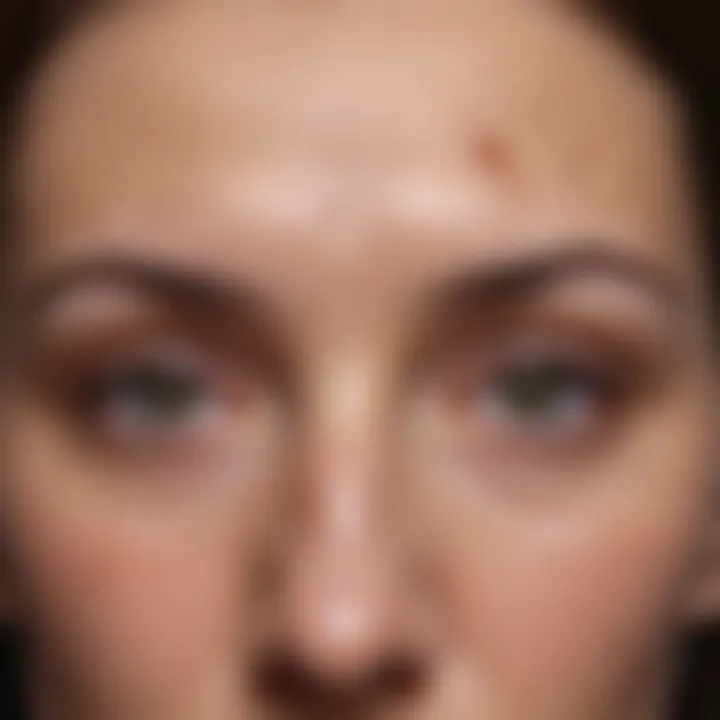Understanding Lipomas on the Forehead: Causes and Management


Intro
Lipomas on the forehead represent a unique area of inquiry within dermatology. These benign tumors, primarily composed of adipose tissue, often raise concerns that span both cosmetic and health contexts. As these formations can occur just beneath the skin, their visibility can impart significant psychological effects on individuals. Understanding lipomas involves several threads, including their underlying causes, diagnostic techniques, and management strategies. The present examination delves into these areas, offering insights that are both informative and practical for students, researchers, educators, and professionals in the field.
Key Findings
Major Results
Lipomas, while generally non-threatening, can manifest in various forms on the forehead. They usually present as soft, movable lumps and are generally painless. The primary factor contributing to their development is genetics, with familial history often playing a pivotal role. The research suggests an incidence of lipomas varies but tends to increase with age. Moreover, though they are rarely symptomatic, their presence can impact one's appearance, leading to emotional distress.
"Understanding both the benign nature and the management options for lipomas can alleviate much of the concern experienced by affected individuals."
Discussion of Findings
In discussing the findings, it is observed that the management of lipomas is widely dependent on individual patient needs and preferences. While some individuals may opt for observation, others might prefer surgical removal for cosmetic reasons. The article aims to outline these options clearly while reinforcing the need for thorough clinical evaluation when diagnosing lipomas versus other dermatological conditions. This ensures that potential complications can be avoided and that patients receive tailored treatment plans.
Methodology
Research Design
The approach taken for this article includes a comprehensive review of current literature, clinical case studies, and patient surveys. This multifaceted design aids in painting a complete picture of the topic at hand.
Data Collection Methods
Data have been gathered from a variety of sources including:
- Peer-reviewed journals
- Medical databases such as PubMed
- Case reports from dermatologists
- Patient interviews conducted through forums such as reddit.com
These diverse methods provide a robust foundation for understanding the implications of forehead lipomas.
As the exploration continues, the following sections will detail specific characteristics, diagnostic measures, and the array of treatment options available.
Prologue to Lipomas
Understanding lipomas is crucial for both medical professionals and individuals who may encounter these growths. Lipomas, though benign, can carry both aesthetic and medical implications. Their presence on the forehead, in particular, raises specific concerns due to the visibility of this facial area. Knowing the nature of lipomas, how they develop, and the best practices for managing them can significantly inform treatment options and patient care. This section lays the groundwork for a deeper exploration of lipomas, offering essential insights that will benefit anyone seeking clarity on this topic.
Defining Lipomas
Lipomas are soft, movable lumps usually composed of fat cells. Typically, they are slow-growing and may vary in size, but they are generally harmless. These growths can appear anywhere on the body; however, forehead lipomas are particularly noticeable. Clinically, a lipoma is usually asymptomatic unless they press against surrounding tissues. Diagnosis often involves physical examination and, in some cases, imaging techniques or biopsies for distinctive identification. Understanding their definition is vital for recognizing these formations and knowing when to seek professional help.
Epidemiology of Lipomas
Lipomas are considered one of the most common types of soft tissue tumors. They occur in approximately 1% of the population, with varying rates based on age, sex, and other factors. Research indicates that they are more prevalent in middle-aged adults, although they can appear in younger individuals as well. Gender disparities also exist, with men slightly more likely to develop lipomas than women.
Factors influencing the prevalence include genetics and lifestyle. Certain hereditary conditions, such as familial multiple lipomatosis, can increase the likelihood of developing multiple lipomas throughout life. Further understanding of epidemiology aids in identifying risk groups and implementing targeted management strategies.
Anatomy of the Forehead
Understanding the anatomy of the forehead is vital in the study of lipomas in this area. The forehead serves as a prominent part of the human face, which makes it a focus of aesthetic considerations. Lipomas, which are benign tumors, can have both physical and psychological implications when they occur on the forehead. Providing a clear understanding of the skin and underlying structures helps in diagnosing and managing these conditions effectively.
Skin Structure Basics
The skin on the forehead consists of multiple layers with distinct functions. It includes the epidermis, dermis, and subcutaneous tissue. The epidermis is the outermost layer that offers protection against external elements. Below this lies the dermis, which houses blood vessels, nerves, and connective tissue, providing structural support. Finally, the subcutaneous tissue contains fat cells, which is crucial in the formation of lipomas.
Understanding the organization of these layers is essential. Specifically,
- Epidermis: Absorbs UV radiation and helps prevent pathogen entry.
- Dermis: Contains collagen and elastin, contributing to skin strength and elasticity.
- Subcutaneous Tissue: Acts as an insulator and shock absorber.
The presence of fatty tissue in the subcutaneous layer is significant because it is where lipomas originate.
Fatty Tissue Distribution
Fatty tissue distribution on the forehead varies among individuals. In the subcutaneous layer, adipose tissue may accumulate in certain areas, leading to the formation of lipomas. These tumors can be soft or firm, varying in size from a few millimeters to several centimeters. The two primary factors influencing this distribution are genetic predisposition and local anatomic features.


When we consider lipomas on the forehead, recognizing their potential to occur in areas where fatty tissue is more prevalent can guide both diagnosis and treatment.
Moreover, certain specific aspects to keep in mind include:
- Location: Lipomas can appear centrally or laterally on the forehead, depending on where the fatty tissue is most concentrated.
- Appearance: Typically, lipomas present as mobile, soft lumps under the skin, distinct from the surrounding tissues.
Characteristics of Lipomas on the Forehead
Understanding the characteristics of lipomas on the forehead is crucial for both diagnosis and management. These benign tumors, while mostly harmless, can have significant implications for the patient’s emotional and physical well-being. Knowing their typical appearance and associated symptoms aids in early recognition and can help in effective treatment planning. This section will delve into these aspects in detail.
Typical Appearance
Lipomas typically present as soft, movable lumps under the skin. On the forehead, they are often round or oval in shape and can vary in size from small, less than one centimeter, to larger masses. Color usually matches the surrounding skin, which makes them slightly harder to detect unless one is specifically looking for them.
Typically, these tumors feel doughy and can be easily pushed around under the skin. The texture should not be painful, distinguishing them from other conditions that might resemble a lipoma. As they can grow slowly, they may become more prominent over time, adding to the aesthetic concerns of affected individuals.
It is important to note that while these characteristics are defining, variations do exist. Some lipomas may have a more fibrous texture or could be associated with other tissue types, impacting their overall appearance. In some cases, multiple lipomas can develop in a single person, a condition called lipomatosis.
Common Symptoms
Most of the time, lipomas do not produce significant symptoms. However, some patients may experience discomfort if the lipoma presses on nearby structures such as nerves. Commonly reported symptoms include:
- Tenderness: Light pressure on the lipoma can sometimes cause discomfort.
- Movement: The ability to move the lipoma under the skin is a typical finding.
- Aesthetic Concerns: Many individuals report feeling self-conscious about the visible presence of a lipoma on the forehead.
Despite their benign nature, it’s essential for patients to monitor any changes in size, appearance, or associated symptoms. New growth or changes could indicate a different underlying condition that may require further evaluation.
Always consult a healthcare professional for an accurate assessment if any concerning changes occur.
Understanding the typical appearance and common symptoms of lipomas equips individuals with the knowledge necessary to seek medical advice if needed. It also fosters an awareness of when self-examination is crucial, promoting proactive healthcare behavior.
Causes of Lipomas
Understanding the causes of lipomas is essential for several reasons. First, it allows for a better grasp of why these benign tumors develop, which can lead to improved treatment and prevention strategies. Knowing the underlying factors that influence lipoma formation can also help individuals assess their personal risk levels. Furthermore, this knowledge cultivates deeper awareness among healthcare providers about the various aspects of these growths, aiding in clinical decision-making and patient education.
Genetic Factors
Genetic factors play a significant role in the development of lipomas. Research indicates that individuals with a family history of these tumors are at a higher risk of developing them. Certain genetic conditions, such as familial multiple lipomatosis, can result in multiple lipomas forming throughout the body. Inheritance patterns typically suggest a dominant trait, which means that just one affected parent can pass the condition to their offspring.
Studies involving families with a high incidence of lipomas reveal that specific genetic markers may predispose individuals to the condition. Knowledge of these genetic connections helps not only in identifying risk but also in determining the need for monitoring and potential interventions.
Environmental Influences
Environmental factors can also contribute to the occurrence of lipomas. While research in this area is still developing, several elements have been suggested to play a role. For example, obesity and metabolic disorders may create a favorable environment for the growth of lipomas. Poor diet, sedentary lifestyle, and certain hormonal changes could also influence the likelihood of lipoma development.
Additionally, some studies suggest that physical trauma might be a trigger for lipoma formation in susceptible individuals. Understanding these environmental influences can offer insights into prevention strategies. Lifestyle modifications, such as maintaining a healthy weight and staying active, may reduce the risk for some individuals. Thus, recognizing the interplay between genetics and environment becomes crucial in managing one's health and understanding the potential for lipoma formation.
Diagnosis of Lipomas
Diagnosing lipomas on the forehead is a crucial step in distinguishing these benign tumors from other skin or soft tissue formations. Accurate diagnosis helps to alleviate concerns and guide appropriate management. Understanding the diagnostic processes can aid healthcare professionals in delivering better patient outcomes. This section will elaborate on the essential elements of diagnosis, including clinical evaluations, imaging techniques, and histopathological examinations.
Clinical Evaluation
A thorough clinical evaluation is often the first step in diagnosing lipomas. During this process, a healthcare provider will conduct a detailed physical examination of the forehead area. They will assess the size, shape, and texture of the lump. Key characteristics such as mobility and firmness are noted, as these features help differentiate lipomas from other conditions. Providers may also review the patient’s medical history, looking for any genetic predispositions that could explain the presence of multiple lipomas.
Imaging Techniques
Ultrasound
Ultrasound is a widely used imaging technique in diagnosing lipomas. This method utilizes sound waves to produce images of the soft tissue, revealing the characteristics of the mass. One key characteristic of ultrasound is its ability to identify the boundaries of a lipoma. This can help determine whether the mass is encased within the surrounding tissue or if it is well-defined.
The uniqueness of ultrasound lies in its non-invasive nature and real-time imaging. It allows for immediate feedback, enabling quick assessments. One of the greatest advantages of ultrasound is that it does not involve radiation exposure, making it a favorable option for patients.
However, it does have its limitations. For example, ultrasound may not provide detailed information about deeper structures or surrounding tissues, which sometimes necessitates further imaging techniques.


MRI
Magnetic Resonance Imaging, commonly known as MRI, is another imaging option that can provide valuable information in diagnosing forehead lipomas. MRI is particularly significant in assessing the depth of the mass within the tissue layers. The key characteristic of MRI is its high resolution, which affords clear images of soft tissue distinctions that are beneficial for diagnostic certainty.
MRI's unique feature is its ability to visualize tumors in three dimensions. This detailed view can assist clinicians in planning surgical interventions if needed. One advantage of MRI over ultrasound is its capacity to capture more intricate details about surrounding structures, making it useful in cases where adjacent tissues might be affected.
Nonetheless, MRI is more time-consuming and expensive than ultrasound. Additionally, it is less accessible in some healthcare settings, which can make ultrasound a more practical choice in initial evaluations.
Histopathological Examination
In some cases, a histopathological examination may be necessary to confirm the diagnosis of lipomas. This technique involves taking a tissue sample of the lipoma and examining it under a microscope. Histopathology helps to ensure that the mass is indeed a lipoma and not another type of tumor. The examination focuses on the adipose (fat) tissue composition, which is a hallmark of lipomas. This definitive diagnosis is important, particularly when distinguishing lipomas from similar but potentially malignant lesions.
A clear histopathological assessment can mitigate anxiety regarding misdiagnosis, ensuring patients receive appropriate management paths going forward.
Through the combined use of clinical evaluation, imaging techniques, and histopathological assessments, healthcare providers can effectively diagnose forehead lipomas. Understanding these methodologies enhances diagnostic precision, fostering better patient outcomes.
Differential Diagnosis
Differential diagnosis is a crucial component in the evaluation of lipomas, especially those located on the forehead. It involves distinguishing lipomas from other similar conditions that may present with similar features. Accurate differentiation is essential, as it informs clinical management decisions. Recognizing the specific types of growths can lead to appropriate treatment, which in turn minimizes patient anxiety and promotes effective care.
Other Benign Tumors
When examining a forehead mass, one must consider a range of benign tumors. The most common types include:
- Epidermoid cysts: These are small, round lumps that often appear due to blocked hair follicles. They can be mistaken for lipomas .
- Dermatofibromas: These are firm, benign tumors that can develop on the skin. Their texture is much denser than that of lipomas.
- Neurofibromas: These tumors can develop from nerve fibers and are softer and mobile, unlike the typically soft and non-tender lipomas.
Differentiating these conditions from lipomas is vital, as the treatment approaches can vary. Surgical excision may be required for some but is generally not necessary for simple lipomas.
Malignant Lesions
While lipomas are benign, it is important to rule out malignant lesions that may mimic lipomas. The following are key considerations:
- Lipoblastoma: This is a rare, benign tumor, often found in children. It may present similarly to a lipoma but requires a different surgical approach.
- Sarcomas: Some soft tissue sarcomas can resemble lipomas. Their aggressive nature necessitates prompt diagnosis and treatment.
- Metastatic cancers: In rare cases, cancer from other locations may spread to the forehead, creating lumps that can be mistakenly identified as lipomas.
- To identify these malignant conditions, clinicians often rely on imaging studies and histopathological examination. Imaging methods such as ultrasound or MRI can provide critical insights about the structure and behavior of the mass. Moreover, a biopsy may be performed to confirm the diagnosis.
It is paramount that healthcare professionals conduct a thorough assessment to ensure accurate diagnosis and appropriate management of forehead lesions. Adequate knowledge of differential diagnosis is essential for safeguarding patient health and ensuring optimal treatment outcomes.
Through thoughtful consideration of benign and malignant conditions, clinicians can provide precise diagnoses. This approach ultimately leads to timely interventions that enhance patient quality of life. Understanding the nuances of differential diagnoses will aid those affected by lipomas on the forehead, affording them reassurance and clarity.
Treatment Options for Forehead Lipomas
Addressing forehead lipomas is essential both aesthetically and medically. Options for treatment vary based on the size, location, and symptoms associated with the lipoma. Understanding these options can help patients or medical professionals make more informed choices. Treatment can alleviate concerns regarding appearance as well as potential complications in the future.
Surgical Removal
Surgical removal is the most common and efficient method of treating forehead lipomas. This procedure involves excising the lipoma entirely with a scalpel. The primary goal is to eliminate the fatty tissue while minimizing damage to the surrounding skin. Here are key points concerning surgical removal:
- Effectiveness: Surgical removal provides a permanent solution, as it completely removes the tumor.
- Recovery: The recovery time varies but is typically quick, depending on factors like size and the individual's healing process.
- Aesthetic Outcomes: Surgeons aim to create minimal scarring. However, scars can form and may be visible depending on the surgical technique used.
Surgical removal remains the gold standard for definitive lipoma treatment, ensuring the complete extraction of the tumor and reducing chances of recurrence.
Minimally Invasive Techniques
For patients looking for alternatives to traditional surgery, minimally invasive techniques can offer effective solutions. Methods like liposuction can reduce scarring and recovery time while still addressing the lipoma. Not all cases are suitable for these approaches, but here are some important aspects:
- Procedure Overview: In liposuction, a thin tube is inserted, and the fatty tissue is suctioned out. This method can often be performed under local anesthesia.
- Reduced Scarring: The small incisions generally lead to less noticeable scars when compared to open surgical excision.
- Smaller Lipomas: This technique is most effective for smaller lipomas. Larger or deeper ones may not respond well to this treatment.
Minimally invasive techniques are becoming more popular. They align with patient desires for less invasive options while still achieving satisfactory cosmetic outcomes.
Post-operative Care
Post-operative care is crucial for individuals who have undergone surgery to remove lipomas from the forehead. This phase of treatment encompasses various aspects that promote healing and reduce complications. Proper management can ensure a smoother recovery and addresses both physical and psychological well-being.
Wound Care Management


Wound care management involves several steps that are essential for optimal healing. After the surgical procedure, patients are typically provided with specific instructions regarding how to care for the surgical site. This includes:
- Keeping the area clean: It is important to gently clean the wound with mild soap and water, taking care to avoid irritation.
- Applying ointments or dressings: Doctors may recommend antibiotic ointments or specific dressings to prevent infection and protect the wound.
- Monitoring for signs of infection: Patients should be alert for symptoms such as increased redness, swelling, or discharge, which may indicate infection. Prompt reporting of these symptoms to a healthcare provider is necessary.
Adhering to these guidelines helps minimize the risk of complications and supports better outcomes post-surgery. Information on wound care can often be found through reliable medical sources, such as Wikipedia or Britannica.
Monitoring for Recurrence
Monitoring for recurrence is another significant aspect of post-operative care. Although lipomas are generally benign and not likely to return after removal, some cases may warrant vigilance. Patients should be aware of the following:
- Regular follow-ups with the doctor: Scheduling routine check-ups allows for early detection if a lipoma begins to form again.
- Self-examination: Patients are encouraged to perform self-examinations periodically. Checking for any new lumps or changes in existing scars is essential.
- Documenting changes: Keeping a record of any new symptoms or changes noticed can assist healthcare providers in assessing the situation effectively.
It is vital to remain proactive in monitoring health post-surgery. Awareness can lead to timely intervention if required.
Psychosocial Implications
Understanding the psychosocial implications of lipomas on the forehead is crucial for grasping their broader impact on individuals. Lipomas, though benign tumors, can lead to significant psychological and social effects due to their visible nature. The discussion regarding these implications often centers on self-esteem and social perceptions. Both factors interplay in ways that can profoundly affect a person's quality of life. This section will explore these elements in detail and emphasize their relevance in managing the condition.
Impact on Self-esteem
Self-esteem can be particularly affected by the presence of lipomas. The forehead is a prominent area of the face, and any visible irregularity can trigger feelings of self-consciousness. Individuals with lipomas may experience embarrassment or anxiety during social interactions. The impression of being judged or scrutinized can lead to avoidance of social situations, which may further diminish self-worth.
Some studies have shown that physical appearance directly correlates with self-esteem in many people. Those dealing with lipomas often report frustrations about their appearance, leading to a negative self-image. The impact varies from person to person, but professional help may be valuable in instances where self-esteem significantly deteriorates due to these benign tumors. Possible strategies to address self-esteem issues include:
- Counseling or therapy to develop coping mechanisms
- Support groups where individuals can share experiences
- Educational resources about lipomas to demystify the condition
These approaches may help to rebuild self-confidence and encourage healthy social interactions.
Social Perceptions
The way lipomas are perceived socially is another vital aspect. People encountering someone with a visible lipoma might develop misconceptions. For example, they might view such individuals as careless or neglectful about their health. These biases can perpetuate stigma.
In some cultures, visible skin conditions may lead to significant social ostracization or unwarranted scrutiny. This can cause psychological distress for affected individuals. It is essential to raise public awareness about lipomas, emphasizing that they are non-cancerous and unrelated to general health status. Educational initiatives through platforms like Wikipedia or community forums on Reddit can play a role in changing perceptions.
Some factors influencing social perceptions include:
- Cultural attitudes towards physical imperfections
- Media portrayals of beauty and health standards
- Personal experiences and interactions with family and friends
An improved understanding of lipomas can foster compassion and acceptance in social circles, subsequently mitigating the negative implications for individuals affected by these tumors.
Future Directions in Lipoma Research
Research into lipomas, particularly those that occur on the forehead, represents an important field within dermatology and surgical treatments. Understanding the future directions in lipoma research can aid in enhancing diagnostic methods, refining treatment options, and improving patient outcomes. The focus is increasingly on the mechanisms that lead to lipoma formation and recurrence, as well as the psychological impacts associated with these benign tumors.
Understanding Pathogenesis
Pathogenesis plays a crucial role in comprehending why and how lipomas develop. Current studies suggest that genetic predispositions significantly contribute to lipoma formation. Mutations in the genomic structure may lead to abnormal adipocyte growth, creating lipomas in various locations, including the forehead. There is also growing interest in epigenetic factors that might influence the expression of genes related to lipoma development.
Further investigations could lead to identification of specific biomarkers, forming a basis for more precise diagnostic criteria. Understanding the underlying mechanisms not only informs genetic counsel but also hints at potential targets for interventions. This knowledge will assist both researchers and medical professionals in developing tailored treatment plans for individuals affected by lipomas.
Innovations in Treatment Approaches
As lipoma research progresses, so do the treatment methodologies. Traditional surgical approaches, while effective, are often invasive. There is a significant push towards developing minimally invasive treatment options that offer benefits such as reduced scarring and quicker recovery times.
Techniques such as liposuction, while still being studied, show promise for certain types of lipomas. On the horizon are advancements in laser therapy and ultrasound-guided treatments, which could effectively target lipomas non-invasively.
Moreover, researchers are looking into pharmaceutical options that might disrupt the growth of lipomas or even shrink existing ones. These innovative methodologies underscore the importance of ongoing clinical trials to evaluate efficacy and safety.
Future research must also address the integration of patient perspectives in treatment choice, as quality of life is paramount in addressing the effects of lipomas on individuals.
Closure
The conclusion of this article emphasizes the significance of understanding lipomas on the forehead. It serves as a critical synthesis of information that has been presented throughout the different sections. Recognizing the implications of lipomas not only assists in medical diagnosis and treatment, but also addresses the concerns that people may have regarding their appearance and health.
Summarizing Key Insights
In summary, lipomas are benign tumors formed from fatty tissues, often found on the forehead. They present both aesthetic and medical considerations. The main insights include:
- Recognition and Diagnosis: Proper evaluation through clinical assessments and imaging techniques, such as ultrasound and MRI, is essential for accurate diagnosis. Histopathological examination can further confirm the nature of the growth.
- Causes and Risk Factors: Genetic vulnerabilities and environmental influences may lead to the development of lipomas. Awareness of such risk factors can aid in preventive measures or early interventions.
- Management Options: While surgical removal remains the primary treatment for forehead lipomas, minimally invasive techniques are increasingly popular for those seeking less aggressive options.
- Psychosocial Effects: The presence of lipomas can affect an individual’s self-esteem and how they perceive societal judgments about aesthetics. Thus, addressing these implications is important for holistic care.
- Future Research: Ongoing studies into the pathogenesis and innovative treatment solutions highlight the evolving understanding of lipomas, promoting better management strategies in the future.
This article contributes valuable insights into the multifaceted nature of lipomas, informing students, researchers, and professionals who engage in this field of study. Ultimately, the understanding of lipomas is not just a medical endeavor; it is also about addressing the broader concerns of individuals who may be affected by this condition.



